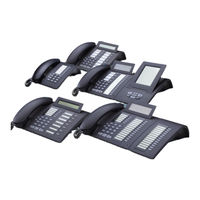Siemens optiPoint 410 advance S V7.0 Manuals
Manuals and User Guides for Siemens optiPoint 410 advance S V7.0. We have 2 Siemens optiPoint 410 advance S V7.0 manuals available for free PDF download: Administrator's Manual, User Manual
Siemens optiPoint 410 advance S V7.0 Administrator's Manual (249 pages)
Siemens IP Phone - IP Telephone User Manual
Table of Contents
-
Intended Use18
-
Service18
-
Installation19
-
Mini Switch22
-
Control Keys30
-
Capabilities31
-
Network31
-
Management31
-
Speech32
-
Dtmf33
-
Overview34
-
Registration37
-
Dhcp38
-
Dns41
-
Sntp43
-
Snmp43
-
Routing44
-
Dls45
-
Phone Menu47
-
SIP Features64
-
Multiline68
-
Applications79
-
Java Proxy79
-
WAP Settings81
-
File Formats84
-
Download86
-
Use SNMP92
-
Port Control99
-
Survivability100
-
Overview103
-
Implementation104
-
Web Interface109
-
Web Pages113
-
SIP Environment115
-
SIP Features116
-
File Transfer118
-
Time and Date120
-
Snmp121
-
Speech121
-
Ringer Settings122
-
Function Keys124
-
Dial Plan131
-
Feature Access133
-
User Mobility134
-
RTP Statistics141
-
Security144
-
Restart Terminal144
-
Port Control145
-
Survivability147
-
Phone Menu148
-
Editors155
-
Text Editor155
-
Switch Editor157
-
Number Editor157
-
Password Editor158
-
Gradient Editor158
-
IP Number Editor159
-
Offset Editor161
-
Action on Submit162
-
Address Book162
-
Alert Indication163
-
Allow Refuse164
-
Append Codes164
-
Audio Loop Test165
-
Audio Mode165
-
Callback Uris169
-
Call Park URI169
-
Call Pickup URI169
-
Check for Update169
-
Config DLS Port170
-
Date/Time173
-
Daylight Saving174
-
Default Music174
-
Default Route174
-
Description174
-
Dial Plan176
-
Dial String180
-
Display ID182
-
Display ID Use182
-
Display Test182
-
Domain Name182
-
DSM Firmware184
-
DSM Logo184
-
DSS Realm184
-
DSS User ID185
-
DSS Password185
-
Emergency Number185
-
Feature Access185
-
Feature Code186
-
Feature Toggle186
-
Feature URI186
-
FTP Account Name187
-
FTP Passive Mode187
-
FTP Password187
-
FTP Path188
-
FTP Username188
-
Function Key188
-
Group Pickup URI189
-
Hide on DSM189
-
Home Page189
-
Hot/Warm Phone190
-
IP Routing191
-
Key Label192
-
Key Test193
-
Layer 2/3193
-
Layer 2 Default193
-
Layer 2 Voice194
-
Last Restart194
-
LDAP Server Port194
-
LDAP Template195
-
LED Test196
-
Line Key196
-
Line Monitor198
-
Line Shared Type200
-
Line Password200
-
Line Realm201
-
Line Ring201
-
Line User ID201
-
MAC Address202
-
Managed Profile202
-
Mobility Feature203
-
Outbound Proxy205
-
PC Port Settings206
-
Ping207
-
Port Control207
-
QDC Address207
-
QDC Port208
-
RAM Test210
-
Ringer Settings211
-
Rollover Type212
-
Rollover Volume212
-
ROM Test212
-
RTP Packet Size212
-
RTP Version212
-
Show Focus213
-
SIP Addresses214
-
SIP Auto Answer214
-
SIP Password215
-
SIP Realm215
-
SIP Routing216
-
SIP Server Type216
-
SIP Transport217
-
SIP User ID218
-
SNMP MIB2 Errors218
-
SNMP Password218
-
System Name220
-
Terminal Mask223
-
Terminal Name223
-
Terminal Number224
-
Time Zone Offset225
-
Versions Info228
-
Voicemail Number228
-
Troubleshooting235
-
Fault Finding235
-
Security238
-
Common Problems242
-
Index245
Advertisement
Siemens optiPoint 410 advance S V7.0 User Manual (242 pages)
Siemens IP Phone User Manual
Table of Contents
-
Introduction
15 -
-
Mobility23
-
Second Call28
-
Making Calls34
-
Reachability37
-
Call Log39
-
Conferencing49
-
Dialing Aids52
-
-
Line Types64
-
Lines65
-
Line Seizure65
-
-
Toggle Key71
-
-
-
-
Settings91
-
-
Language92
-
Date/Time92
-
Call Waiting95
-
Call Join96
-
Contrast96
-
Dialing Mode97
-
Call Display97
-
Music on Hold100
-
Do Not Disturb101
-
Message Waiting101
-
Hold Ringback102
-
Auto Answer103
-
Auto Reconnect103
-
Line Settings107
-
Call Recording112
-
Secure Call Ind112
-
Local Functions113
-
User Password114
-
Lock Phone115
-
Memory116
-
Audio Settings124
-
Ringer Volume125
-
Ringer126
-
Handset Volume127
-
Headset Volume128
-
Room Acoustics128
-
Key Clicks129
-
Rollover Volume129
-
-
-
Mobility Display132
-
Swap Display132
-
-
Incoming Call134
-
Answering a Call135
-
Reject Call136
-
Ringer136
-
Deflect Call137
-
Second Call139
-
Ending a Call146
-
Voice Messages147
-
Making Calls148
-
Off-Hook Dialing148
-
On-Hook Dialing151
-
Callback152
-
Ending a Call154
-
-
Conferencing164
-
Call Log168
-
Dialed Calls168
-
Missed Calls169
-
Received Calls172
-
Forwarded Calls173
-
-
Call Forwarding174
-
Surviveability180
-
Character Input200
-
Web Interface
206-
Menu Structure209
-
Function Keys210
-
Country Settings213
-
Audio Settings214
-
Using Editors
224 -
Appendix
227-
User Menu228
-
Telephone Menu232
-
Dialing232
-
Incoming Calls233
-
-
Index
238
Advertisement

